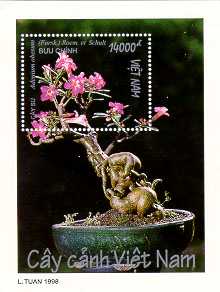Let’s start from the basic understanding of the words, “bonsai,” (Japanese) and “penjing” (Mandarin). “Bonsai” (盆栽) is a Japanese term meaning “tree in a pot “, and “penjing” (盆景) is a Chinese term meaning “landscape in a pot”. With the meanings of these two terms, we have a hint that the Chinese penjing is more of reproducing a miniature landscape than creating a perfect tree as Japanese are trying with their bonsai.
Bonsai on Postage Stamps
During my research on the history of bonsai, I found a beautiful collection of bonsai postage stamps in the homepage of Phoenix Bonsai Society. While it is not surprising to find bonsai on postage stamps of China, Japan, Hong Kong, or Taiwan, there are some countries that I would have never expected bonsai on their postage stamps, for examples, Maldive Islands, Thailand, and Republic of San Marino. I’ve found this very interesting. I guess bonsai is more popular and widely spread in the world than I have expected.
 |
 |
Brief History of Bonsai

Today it is widely accepted that it was the Chinese who first created the miniature landscapes and trees that we now know as bonsai. While bonsai is a Japanese term meaning “tree in a pot “, the art of bonsai is originated in China. In China, growing miniature trees is known as “penjing”, which literally means “landscape in a pot”. Their art is more of reproducing a miniature landscape than creating a perfect tree as Japanese are trying with their bonsai.
Called penjing by the Chinese, bonsai was believed to have had its start in the Han Dynasty. Here, let me share some of the legends and facts surrounding the beginning of bonsai.
Continue reading “Brief History of Bonsai”
Bonsai Care: Why Don’t We Want the Flowers to Bloom?
The time it takes to develop the shapes and train the branches of our bonsai trees is often painfully long. And it will be worse if we make a wrong cut after months of waiting for the bonsai tree to finally has its branches developed as trained.
During the developing and training stage, we surely want our bonsai trees to grow as fast as possible, if not overnight. There are several things we can do to help our bonsai trees to grow and develop it branches faster, and one of these is cutting away all flower buds before they start to bloom.

Yes, I know this is not easy. It is just too cruel to cut away all the buds that will blossom into beautiful flowers. But if you really want your bonsai tree to grow as fast as possible, then you better cut away all the flower buds, so to avoid your tree from spending most of its energy and nutrients on the blossoms.
Rocks for Landscape Penjing (Bonsai)

A few days ago, with Teacher Wong and other lingnan penjing club members, we took hours of long rides to Yingde (英德) in Guangzhou, mainland China in the hope of obtaining some beautiful stones that can be used in our penjing (bonsai in Japanese).
“Penjing” in Chinese literally means “landscape in a pot”. Their art is more of reproducing a miniature landscape than creating a perfect tree as the Japanese are doing with their bonsai. While penjing and bonsai share many similarities, there is one thing that can only be found in penjing but not bonsai, and that’s the rock landscapes.
Guangzhou Penjing (Bonsai) Exhibition
I went to the Guangzhou Penjing (Bonsai) Exhibition in Martyrs’ Park yesterday. With over 350 lingnan penjing (southern style Chinese bonsai), it’s the biggest lingnan penjing exhibition since the founding of the country.


A truly A+ penjing should look just as exquisite when it is naked of leaves, as the times when it is blooming vigorously with leaves and flowers.
Continue reading “Guangzhou Penjing (Bonsai) Exhibition”



